Keyword
eReefs
32 record(s)
Type of resources
Topics
Keywords
Contact for the resource
Provided by
Formats
Update frequencies
Status
draft
-
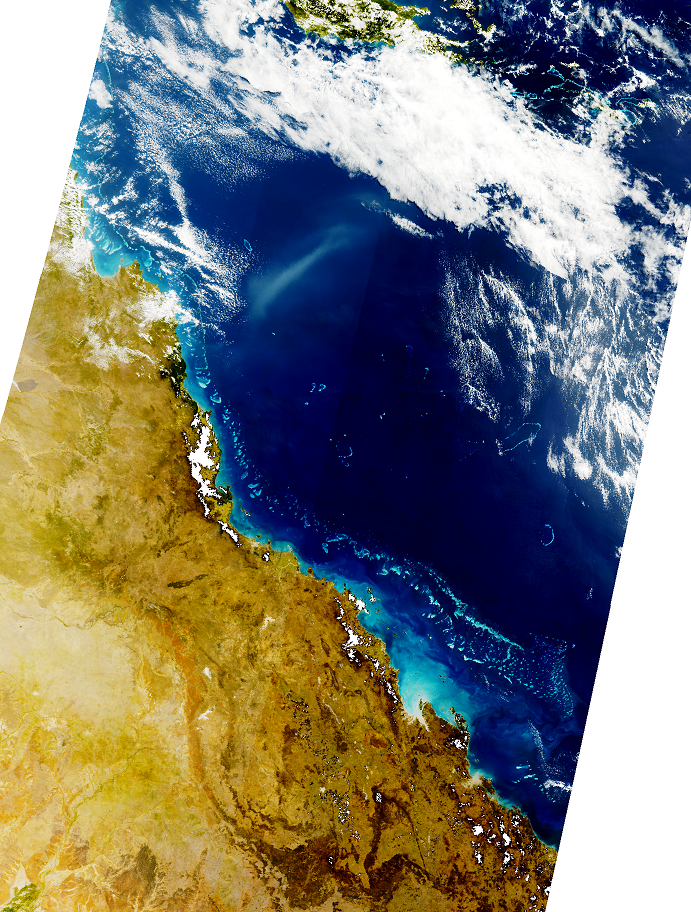
Sentinel-3 OLCI reduced resolution (approximately 1000m-pixel size) daily Level 1B true-colour quicklooks produced by CSIRO under eReefs Phase 5 delivered in GeoTIFF format.
-
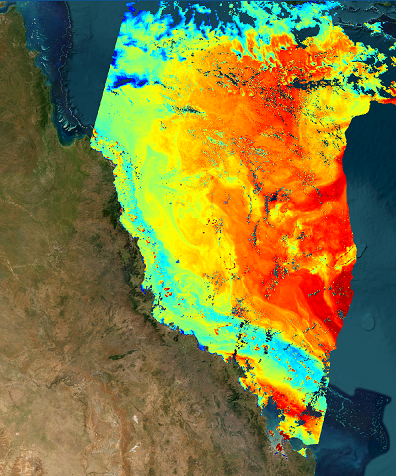
Sentinel-3 OLCI reduced resolution (approximately 1000m-pixel size) daily reprojected Level 2P above-water spectral remote sensing reflectance produced by CSIRO under eReefs Phase 5 using the FUB-CSIRO Coastal Water Processor (detailed description at https://doi.org/10.1016/j.rse.2021.112848). This product was derived from Level 2 geophysical quantities, and placed onto a regular grid using nearest neighbor resampling. Standard Level 1 quality flags have been applied to pre-mask and quality control the data (see file_version_quality_control). Additional algorithm input and output out-of-range flags (in_out_OR_combined_flags) are provided to further quality control the data. These flags have not been applied to pre-mask the data.
-
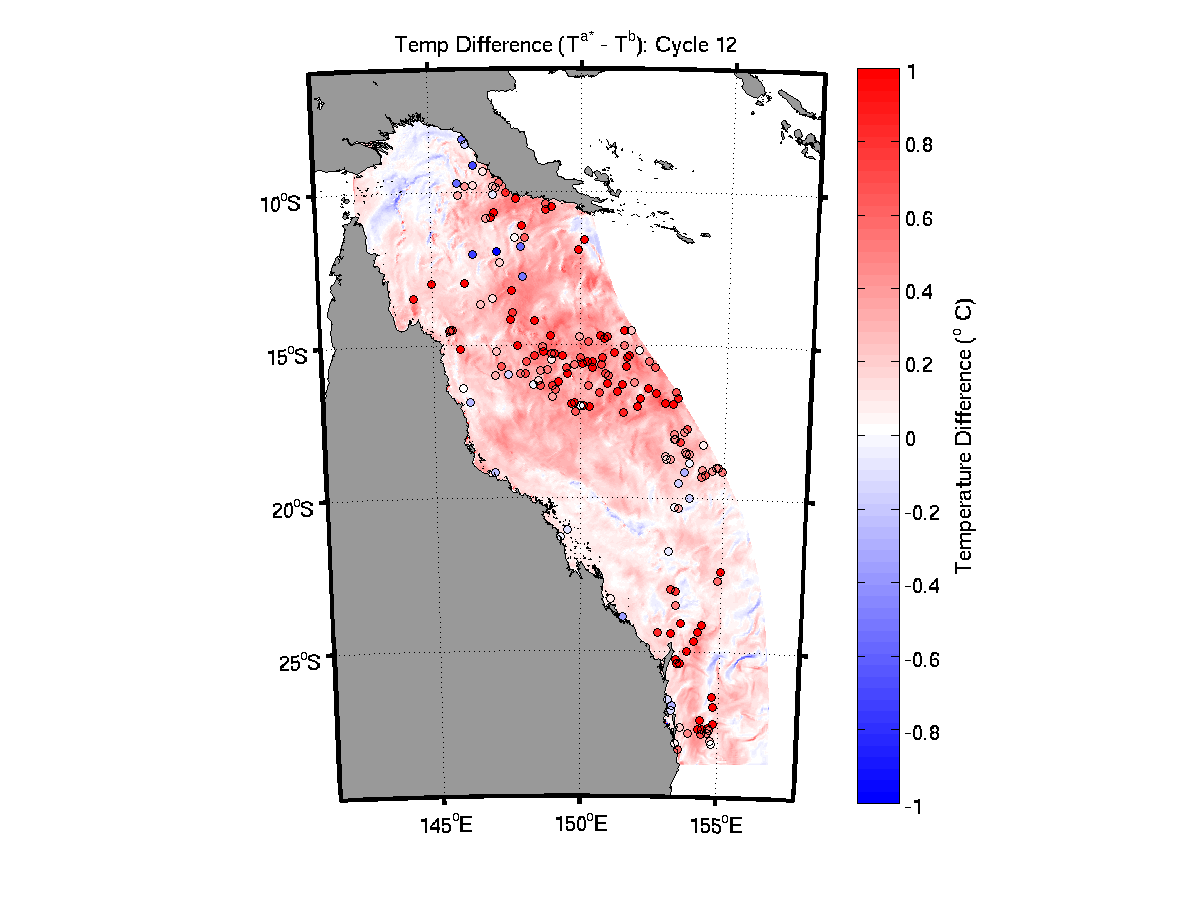
**This sample dataset was decomissioned in May 2022, and is no longer available via the NCI THREDDS server. Please contact the eReefs team if you need access to this data.** This is the eReefs GBR 4 km resolution Data Assimilating (DA) hydrodynamic SHOC model data. The Ensemble Optimal Interpolation (EnOI) system assimilaties a combination of temperature data from moorings (AIMS and GBROOS/IMOS), gliders (CSIRO and IMOS) and SST (GHRSST L3S from IMOS). This product is the first version of a reanalysis undertaken for the GBR4 grid. The DS system is run with a cycle length of 2 days, and assimilates temperature data that fall within a 6 hour window either side of the analysis time. The mean forecast error ranges from 0.4 degrees C in the "dry" season to 0.7 degrees C in the "wet" season
-

**This sample dataset was decomissioned in May 2022, and is no longer available via the NCI THREDDS server. Please contact the eReefs team if you need access to this data.** This is the eReefs GBR 4 km resolution complete hydrodynamic Sparse Hydrodynamic Ocean Code (SHOC) model data v1.85. It is comprised of ALL the tracers that are present in the SHOC model. The output format is non-CF compliant as it is a "standard" SHOC ALL file. It is based on the Arakawa-C grid with velocities on face centres that are oriented relative to the grid while all tracer values and surface elevation values are cell centred.
-
The pesticide diuron from urban and agricultural runoff is detected at concentrations above current water quality guidelines in the Great Barrier Reef (GBR) marine environment. We quantified the load of the pesticide diuron entering GBR waters using the GBR-Dynamic SedNet catchment model. After comparison of simulated distributions with observations at 11 monitoring sites we determined a half-life of diuron in GBR marine waters of 40 days. The 1 km resolution eReefs marine model (GBR1: version GBR1_H2p0_Cq3pe1_Dhnd) was nested inside the 4 km eReefs marine model (GBR4: version GBR4_H2p0) to achieve stable and reliable boundary forcing. Diuron only enters the marine model from the catchments. Diuron at the ocean boundaries is set to 0 and if diuron leaves the 1km model boundary it does not return. The simulation period is from January 2016 to July 2018. The GBR1 hydrodynamic model was forced by wind, atmospheric pressure gradients, surface heat fluxes and evaporation / precipitation fluxes, tides, and waves and calculates temperature, salinity, elevation and offshore currents, integrating on a 1.2 second barotropic time step. The hydrodynamic model calculates the mean volume flux through model cell faces over a 1-hour period (Herzfeld et al., 2016) that are used in a transport model to disperse diuron. The transport scheme was a flux-form semi-Lagrangian advection scheme that applies the fluxes in steps determined by the Lipschitz stability criterion, with a maximum of 1 hour time step. Each model cell contains their own value of diuron based on the hydrodynamics, and so diuron fluctuates hourly in each cell. The eReefs marine model represents freshwater input from 16 rivers located in the GBR. For rivers with freshwater input, GBR1 uses a river boundary condition where freshwater was discharged in a brackish surface plume. This boundary condition provides realistic plume dynamics and avoids excessive offshore transport caused by overestimating the density difference between freshwater plumes and seawater (Herzfeld, 2015, Baird et al., 2017). For the remaining minor rivers, diuron enters GBR coastal waters as loads as a surface flux (Figure 1B). Rivers containing high diuron loads that enter as surfaces fluxes were the Murray, Mossman, Proserpine and Burrum and Plane (very high risk). Some river catchments in GBR-SedNet do not contain diuron loads, (Normanby, Fitzroy, Calliope, Boyne, Styx, Shoalwater and Waterpark) as diuron was not one of the pesticides used or generally found within these catchment areas during frequent monitoring of all pesticides. Individual river plume dispersal was quantified using conservative tracers. A river tracer was specified as a unit concentration in each river flow (e.g., 1 kg m-3). Therefore, a model grid cell with 0.20 concentration of river water will be composed of 20 % river water, and 80 % water that comes either from another river/s or the ocean. Each river has a unique tracer that was individually advected and diffused using a conservation flux-form scheme based on hourly-averaged 3D velocity fields. Similarly, the diuron tracer has a time-varying river concentration in μg L-1 specified by the SedNet catchment model and was advected and diffused in a similar manner to the river tracers.
-
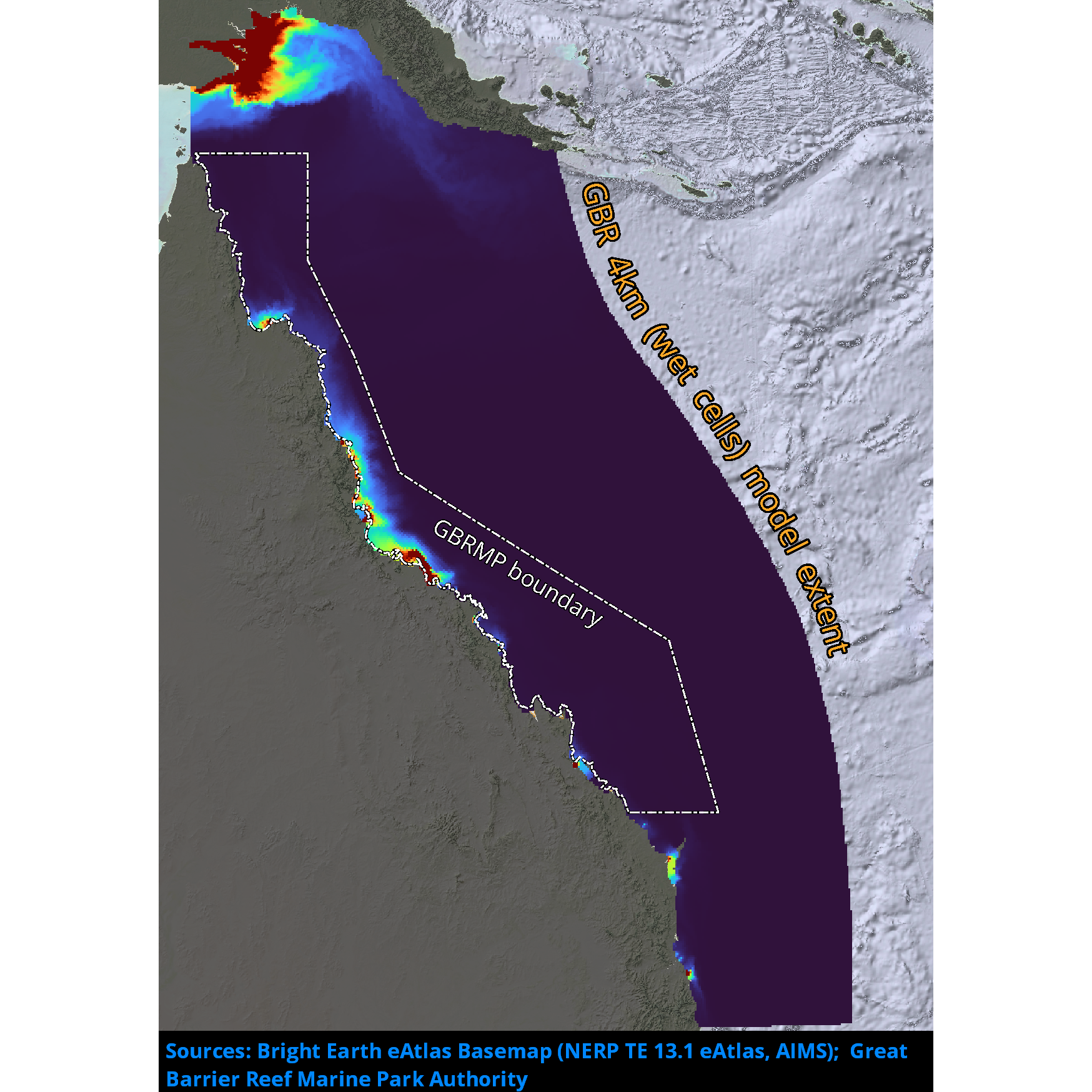
Passive river tracer results derived from version 2.0 of the 4km-resolution regional-scale hydrodynamic model of the Great Barrier Reef (GBR4). This model configuration and associated results dataset may be referred to as "GBR4_H2p0_Rivers" according to the eReefs simulation naming protocol. The model ran in near-real-time mode, updating daily, until January 2024 when the 2023/24 monsoon season caused damage to sensors in the catchments, and we lost access to the critical river-flow forcing dataset.
-
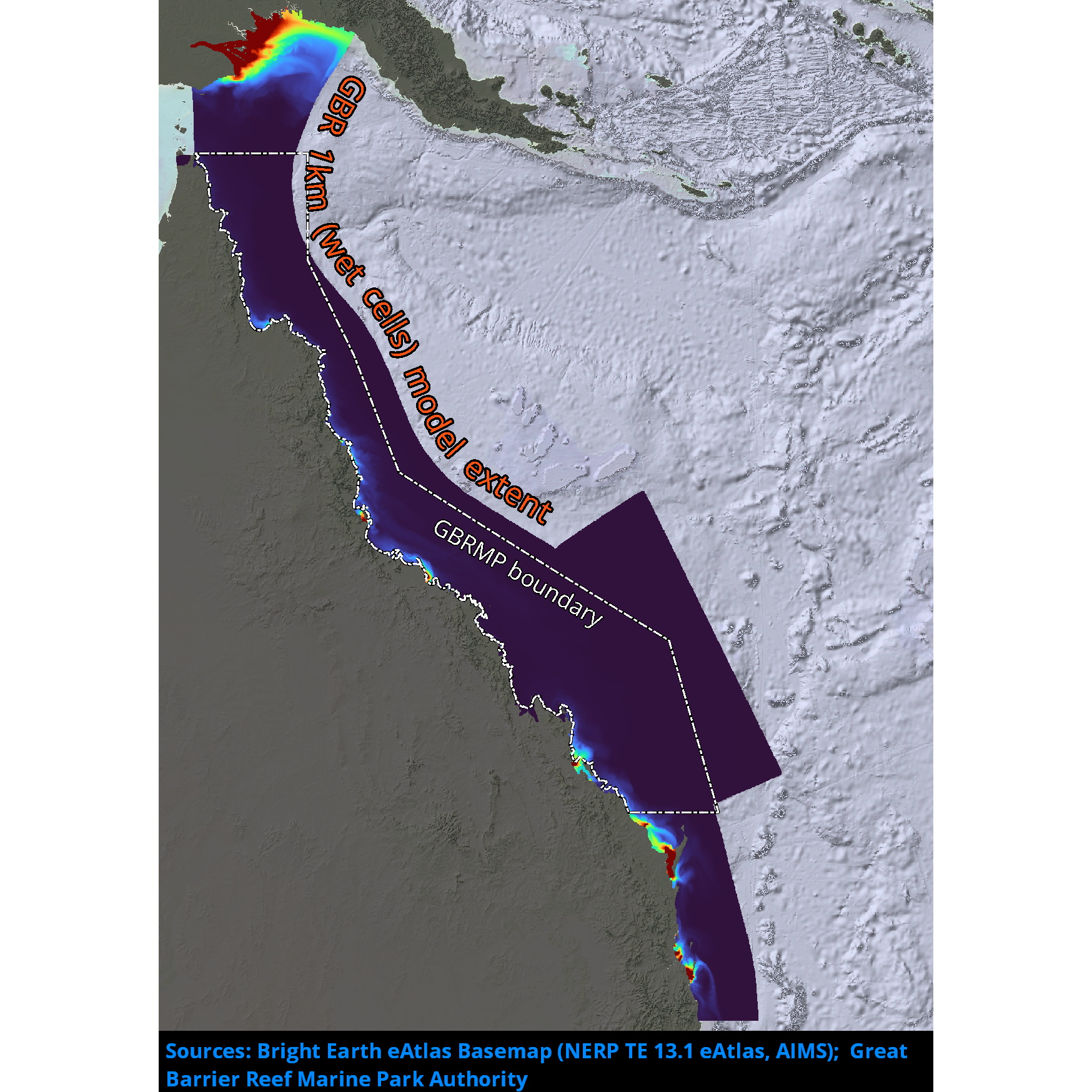
Passive river tracer results derived from version 2.0 of the 1km-resolution shelf-scale hydrodynamic model of the Great Barrier Reef (GBR1). This model configuration and associated results dataset may be referred to as "GBR1_H2p0_Rivers" according to the eReefs simulation naming protocol. The model ran in near-real-time mode, updating daily, until January 2024 when the 2023/24 monsoon season caused damage to sensors in the catchments, and we lost access to the critical river-flow forcing dataset.
-
Sentinel-3 OLCI full resolution (approximately 300m-pixel size) daily reprojected Level 2P water quality (Chl-a, CDOM, TSS) produced by CSIRO under eReefs Phase 5 using the FUB-CSIRO Coastal Water Processor (detailed description at https://doi.org/10.1016/j.rse.2021.112848). This product was derived from Level 2 geophysical quantities, and placed onto a regular grid using nearest neighbor resampling. Standard Level 1 quality flags have been applied to pre-mask and quality control the data (see file_version_quality_control). Additional algorithm input and output out-of-range flags (in_out_OR_combined_flags) are provided to further quality control the data. These flags have not been applied to pre-mask the data.
-
Passive river tracers results for 35 rivers of significance to the Reef 2050 Water Quality Improvement Plan, derived from version 4.0 of the eReefs 4km-resolution regional-scale hydrodynamic model of the Great Barrier Reef (GBR4). This model is forced with: 1. Surface Atmospheric Data: Bureau of Meteorology Atmospheric high-resolution Regional Reanalysis for Australia, using Data Assimilation of Quality Control observations (BARRA); 2. Ocean Boundaries: CSIRO Bluelink Reanalysis using Data Assimilation of Quality Control observations (BRAN2020) model results; 3. Tide: global TPXO tide model; 4. River boundaries: measured stream flow and temperature data for 64 rivers from a combination of the Bureau of Meteorology Grid 2 Grid catchment model (G2Gv3) and the QLD DES Source catchment model. This dataset contains passive tracer results for 35 significant rivers which contribute to calculations for the Reef 2050 Water Quality Improvement Plan Reef Report Cards. This model configuration and associated results dataset may be referred to as "GBR4_H4p0_ABARRAr2_OBRAN2020_FG2Gv3_Dhnd_Rivers" according to the eReefs simulation naming protocol. The model ran in hindcast mode and is complete. It succeeds the GBR4_H2p0_Rivers model as the best available eReefs river tracer model results for its timespan.
-

This dataset has been superseeded by GBR4_H2p0 (2010-09 to present) and it was removed from the NCI fx3 project and THREDDS server in April 2024. An archive copy has been retained by the custodians, and access can be arranged on request. Results from version 1.85 of the 4 km resolution regional-scale hydrodynamic model of the great Barrier Reef (GBR4). It was forced with BlueLink OceanMAPS data on the open boundaries and Bureau of Meteorology model ACCESS-R for surface atmospheric data. The tide was introduced through 22 constituents derived from the global CSR tide model, and 22 river boundaries incorporated measured stream flow and temperature data from QLD DNRM's gauging stations. This model version was published for reference in the SIEF report from January 2016, but was later discovered to have been forced with incorrect (multiplicative error) rainfall levels, and the 2015 results contain salinity errors. This model configuration and associated results dataset may be referred to as "GBR4_H1p85" according to the eReefs simulation naming protocol.
